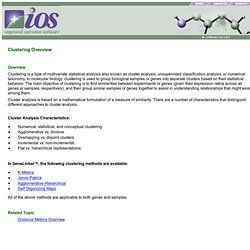

Open source Clustering software. The open source clustering software available here implement the most commonly used clustering methods for gene expression data analysis.

The clustering methods can be used in several ways. Cluster 3.0 provides a Graphical User Interface to access to the clustering routines. It is available for Windows, Mac OS X, and Linux/Unix. Python users can access the clustering routines by using Pycluster, which is an extension module to Python. People that want to make use of the clustering algorithms in their own C, C++, or Fortran programs can download the source code of the C Clustering Library. Cluster 3.0 is an enhanced version of Cluster, which was originally developed by Michael Eisen while at Stanford University. Java TreeView To view the clustering results generated by Cluster 3.0, we recommend using Alok Saldanha's Java TreeView, which can display hierarchical as well as k-means clustering results. Python is a scripting language similar to Perl. License Acknowledgment. Distance Metrics Overview.
Clustering Overview. Overview Clustering is a type of multivariate statistical analysis also known as cluster analysis, unsupervised classification analysis, or numerical taxonomy.

In molecular biology, clustering is used to group biological samples or genes into separate clusters based on their statistical behavior. The main objective of clustering is to find similarities between experiments or genes (given their expression ratios across all genes or samples, respectively), and then group similar samples or genes together to assist in understanding relationships that might exist among them. Cluster analysis is based on a mathematical formulation of a measure of similarity. There are a number of characteristics that distinguish different approaches to cluster analysis. Cluster Analysis Characteristics: Numerical, statistical, and conceptual clustering. In GeneLinker™, the following clustering methods are available: All of the above methods are applicable to both genes and samples.
Related Topic: Principal component analysis. PCA of a multivariate Gaussian distribution centered at (1,3) with a standard deviation of 3 in roughly the (0.878, 0.478) direction and of 1 in the orthogonal direction.

The vectors shown are the eigenvectors of the covariance matrix scaled by the square root of the corresponding eigenvalue, and shifted so their tails are at the mean. Principal component analysis (PCA) is a statistical procedure that uses orthogonal transformation to convert a set of observations of possibly correlated variables into a set of values of linearly uncorrelated variables called principal components. The number of principal components is less than or equal to the number of original variables.
PCA is closely related to factor analysis. Factor analysis typically incorporates more domain specific assumptions about the underlying structure and solves eigenvectors of a slightly different matrix. PCA is also related to canonical correlation analysis (CCA). Details[edit] that map each row vector , given by or. Math: Free Courses. Free Statistics - Free Statistical Software. Statistics, StatSoft Textbook. "Thank you and thank you again for providing a complete, well-structured, and easy-to-understand online resource.

Every other website or snobbish research paper has not deigned to explain things in words consisting of less than four syllables. I was tossed to and fro like a man holding on to a frail plank that he calls his determination until I came across your electronic textbook...You have cleared the air for me. You have enlightened. You have illuminated. You have educated me. " — Mr. "As a professional medical statistician of some 40 years standing, I can unreservedly recommend this textbook as a resource for self-education, teaching and on-the-fly illustration of specific statistical methodology in one-to-one statistical consulting.
. — Mr. "Excellent book. . — Dr. "Just wanted to congratulate whoever wrote the 'Experimental Design' page. . — James A. Read More Testimonials >> StatSoft has freely provided the Electronic Statistics Textbook as a public service since 1995. Proper citation: PermutMatrix Clustering.